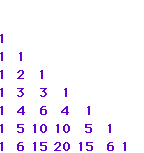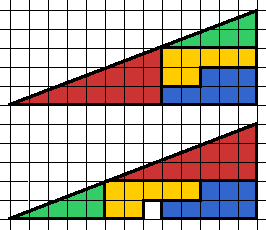
Angewandte Mathematik
Fibonacci Zahlen/Serie/Rekursion
0 1 --the series starts like this.
0+1=1 so the series is now
0 1 1
1+1=2 so the series continues...
0 1 1 2 and the next term is
1+2=3 so we now have
0 1 1 2 3 and it continues as follows ...
The first 30 Fibonacci numbers
n : F(n)=factorization
0 : 0
1 : 1
2 : 1
3 : 2
4 : 3
5 : 5
6 : 8 = 23
7 : 13
8 : 21 = 3 x 7
9 : 34 = 2 x 17
10 : 55 = 5 x 11
11 : 89
12 : 144 = 24 x 32
13 : 233
14 : 377 = 13 x 29
15 : 610 = 2 x 5 x 61
16 : 987 = 3 x 7 x 47
17 : 1597
18 : 2584 = 23 x 17 x 19
19 : 4181 = 37 x 113
20 : 6765 = 3 x 5 x 11 x 41
21 : 10946 = 2 x 13 x 421
22 : 17711 = 89 x 199
23 : 28657
24 : 46368 = 25 x 32 x 7 x 23
25 : 75025 = 52 x 3001
26 : 121393 = 233 x 521
27 : 196418 = 2 x 17 x 53 x 109
28 : 317811 = 3 x 13 x 29 x 281
29 : 514229
30 : 832040 = 23 x 5 x 11 x 31 x 61
Here are some patterns people have already noticed in the final digits of the Fibonacci numbers:
Is there a pattern in the final digits?
Yes!
It takes a while before it is noticeable. In fact, the series is just 60
numbers long and then it repeats the same sequence again and again all the way
through the Fibonacci series - for ever. We say the series of final digits
repeats with a cycle length of 60.
Yes, there is a pattern here too. After Fib(300) the last two digits repeat the same sequence again and again. The cycle length is 300 this time.
There is a proof of this, but it relies on a special Fibonacci formula called Cassini's Identity:
F(n – 1)F(n + 1) – F(n)2 = (–1)n
col : 0 1 2 3 4 ...
------+---------------
1 0 | 1
1 1 r 1 | 1 1 each number
1 2 1 o 2 | 1 2 1 is the sum of
1 3 3 1 w 3 | 1 3 3 1 the one above it and
1 4 6 4 1 4 | 1 4 6 4 1 the one to the above-left.
... ... ... eg 6 is 3+3 from row above.
Each entry in the triangle on the left is the sum of the two numbers either side of it but in the row above. A blank space can be taken as "0" so that each row starts and ends with "1".
Pascal's Triangle has lots of uses including
Puzzel Fibonacci
Jigsaw Puzzle

It is made up of 4 pieces,
The two L-shaped pieces fit together to make a 3-by-5 rectangle. They can all be arranged into a 13-by-5 triangle as shown here. Rearranging the 4 pieces shows the triangle has a square missing!
What's the answer this time and how is it connected with the Fibonacci Numbers?
The puzzle will work with a green triangle height 1 base 3 and a red triangle
height 2 base 5, and two straight pieces (1-by-3) that make up a 2-by-3
rectangle. Rearranging them this time makes the small rectangle 1 square
smaller this time so the two straight pieces have to overlap.
Similarly, using triangles of height 3 base 8 and height 5 base 13 the rectangle
again loses one square.
| small green triangle |
large red triangle |
rectangle green width red height height x base = Area |
rectangle red width green height height x base = Area |
Rectangle Area Difference |
|||
|---|---|---|---|---|---|---|---|
| height | base | height | base | ||||
| smaller puzzle |
1 | 3 | 2 | 5 | 2 x 3 = 6 | 1 x 5 = 5 | -1 |
| puzzle above |
2 | 5 | 3 | 8 | 3 x 5 = 15 | 2 x 8 = 16 | +1 |
| larger puzzle |
3 | 8 | 5 | 13 | 5 x 8 = 40 | 3 x 13 = 39 | -1 |
| larger puzzle |
5 | 13 | 8 | 21 | 8 x 13 = 104 | 5 x 21 = 105 | +1 |
Dieser bekannte Trick kann auch 24 = 25 oder 168 = 169 heissen. Immer sind es drei aufeinanderfolgende Fibonaccizahlen, die die Seitenlänge der Dreicke und Trapeze bestimmen, so dass die Teilfiguren geschickt zusammengelegt werden können.
2, 3, 5 : 24= 3 * (3+5) und 25 = 5²
3, 5, 8: 65= 5 * (5+8) und 64 = 8²
5, 8, 13: 168 = 8 * (8+13) und 169 = 13²
usw.
Lösung: Es müssten im Rechteck die Verhältnisse der Dreicksseiten gleich sein.
aber 8/3=2,6666666... und (5+8)/5 = 13/5 = 2,6
/* This program will produce a 3D graphics file in the Inventor format. */
/* Use any Open Inventor or VRML viewer to see the result (the latest */
/* version of Netscape has a free VRML plug-in). */
#include <stdio.h>
#include <math.h>
#define PI 3.141592654
void main(int argc, char **argv)
{
int i, j;
float x, y, z, theta, phi, r, d;
printf("#Inventor V2.0 ascii\n");
printf("Separator {\n");
printf(" DirectionalLight { direction 1 1 1 }\n");
printf(" Separator {\n");
printf(" Material {\n");
printf(" diffuseColor [ .7 .7 0.7 ]\n");
printf(" specularColor [ 1. .4 .0 ]\n");
printf(" }\n");
printf(" Coordinate3 {\n");
printf(" point [\n");
for (i=0; i<1000; i++) {
theta=i/20.; /* Rotation angle */
r=exp(theta*0.09); /* Distance from axis (0.09 is uncoiling factor) */
d=0.33*r; /* Radius relative to r (involute/evolute) */
/* For ornament, add a periodic function to d */
for (j=0; j<50; j++) {
phi=2.*PI*j/49.;
x=d*cos(phi)*cos(theta); z=d*sin(phi);
y=d*cos(phi)*sin(theta);
x+=r*cos(theta); y+=r*sin(theta);
z+=r*0.2; /* Trochospiral factor */
printf("%.3f %.3f %.3f, ", x, y, z);
}
printf("\n");
}
printf(" ]\n");
printf(" }\n");
printf(" ShapeHints {\n");
printf(" vertexOrdering COUNTERCLOCKWISE\n");
printf(" }\n");
printf(" QuadMesh {\n");
printf(" verticesPerColumn 1000\n");
printf(" verticesPerRow 50\n");
printf(" }\n");
printf(" }\n");
printf("}\n");
}
|